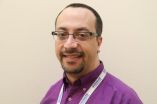(Press-News.org) Two NASA satellites captured visible and infrared pictures that show the massive size of Hurricane Marie. Marie is so large that it is bringing rough surf to the southern coast of California while almost nine hundred miles west of Baja California.
On August 26 at 19:05 UTC (3:05 p.m. EDT) NASA's Terra satellite captured a visible image of Hurricane Marie drawing in the small remnants of Karina. Marie is over 400 miles in diameter, about the distance from Washington, D.C. to Boston, Massachusetts. Hurricane force winds extend outward up to 60 miles (95 km) from the center and tropical storm force winds extend outward up to 205 miles (335 km).
The Atmospheric Infrared Sounder or AIRS instrument that flies aboard NASA's Aqua satellite gathered infrared data on Marie when it passed overhead on Aug. 27 at 6:14 a.m. EDT. An infrared image created from that data showed the coldest cloud top temperatures and strongest thunderstorms were around Marie's center and southern quadrant.
Because of Marie's large size and its movement to the north, it is creating rough surf that is now reaching southern California's shoreline. The National Hurricane Center noted that swells generated by Marie will continue to affect much of the west coast of the Baja California, Mexico peninsula and now including the extreme southern Gulf of California and southern California through Thursday, August 28. Life-threatening surf and rip current conditions are likely as a result of these swells as well as minor coastal flooding.
At 11 a.m. EDT (1500 UTC) Marie's maximum sustained winds had decreased to near 75 mph (120 kph). Marie was centered near latitude 22.3 north and longitude 123.7 west. That's about 880 miles (1,415 km) west of the southern tip of Baja California, Mexico. Marie is moving toward the west-northwest near 14 mph (22 kph) and is expected to turn to the northwest.
As Marie moves in a northerly direction it will be moving over progressively colder waters so the National Hurricane Center forecasts additional weakening in the next two days. My Thursday, Marie is expected to become a post-tropical cyclone.
INFORMATION:
Text credit: Rob Gutro
NASA's Goddard Space Flight Center
NASA sees massive Marie close enough to affect southern California coast
2014-08-27
ELSE PRESS RELEASES FROM THIS DATE:
Scripps Research Institute scientists link alcohol-dependence gene to neurotransmitter
2014-08-27
LA JOLLA, CA – August 27, 2014 – Scientists at The Scripps Research Institute (TSRI) have solved the mystery of why a specific signaling pathway can be associated with alcohol dependence.
This signaling pathway is regulated by a gene, called neurofibromatosis type 1 (Nf1), which TSRI scientists found is linked with excessive drinking in mice. The new research shows Nf1 regulates gamma-aminobutyric acid (GABA), a neurotransmitter that lowers anxiety and increases feelings of relaxation.
"This novel and seminal study provides insights into the cellular mechanisms of ...
Expression of privilege in vaccine refusal
2014-08-27
DENVER (August 27, 2014) – Not all students returning to school this month will be up to date on their vaccinations. A new study conducted by Jennifer Reich, a researcher at the University of Colorado Denver, shows that the reasons why children may not be fully vaccinated depends on the class privilege of their mothers.
According to the National Network for Immunization Information, three children per 1000 in the U.S. have never received any vaccines, with almost half of all children receiving vaccines later than recommended. The number of unvaccinated children has led ...
Dosage of HIV drug may be ineffective for half of African-Americans
2014-08-27
Many African-Americans may not be getting effective doses of the HIV drug maraviroc, a new study from Johns Hopkins suggests. The initial dosing studies, completed before the drug was licensed in 2007, included mostly European-Americans, who generally lack a protein that is key to removing maraviroc from the body. The current study shows that people with maximum levels of the protein — including nearly half of African-Americans — end up with less maraviroc in their bodies compared to those who lack the protein even when given the same dose. A simple genetic test for the ...
Scientists plug into a learning brain
2014-08-27
Learning is easier when it only requires nerve cells to rearrange existing patterns of activity than when the nerve cells have to generate new patterns, a study of monkeys has found. The scientists explored the brain's capacity to learn through recordings of electrical activity of brain cell networks. The study was partly funded by the National Institutes of Health.
"We looked into the brain and may have seen why it's so hard to think outside the box," said Aaron Batista, Ph.D., an assistant professor at the University of Pittsburgh and a senior author of the study published ...
Pitt and Carnegie Mellon engineers discover why learning can be difficult
2014-08-27
PITTSBURGH—Learning a new skill is easier when it is related to ability that we already possess. For example, a trained pianist might learn a new melody more easily than learning how to hit a tennis serve.
Neural engineers from the Center for the Neural Basis of Cognition (CNBC)—a joint program between the University of Pittsburgh and Carnegie Mellon University—have discovered a fundamental constraint in the brain that may explain why this happens. Published as the cover story in the Aug. 28, 2014, issue of Nature, they found for the first time that there are constraints ...
Kessler Foundation scientists study impact of cultural diversity in brain injury research
2014-08-27
West Orange, NJ. August 27, 2014. Kessler Foundation scientists examined the implications for cultural diversity and cultural competence in brain injury research and rehabilitation. The article by Anthony Lequerica, PhD, and Denise Krch, PhD: Issues of cultural diversity in acquired brain injury (ABI) rehabilitation (doi:10.3233/NRE-141079) was published by Neurorehabilitation. Drs. Lequerica and Krch are research scientists in Traumatic Brain Injury (TBI) Research at Kessler Foundation and co-investigators for the Northern New Jersey TBI Model System.
Cultural sensitivity ...
New smartphone app can detect newborn jaundice in minutes
2014-08-27
Newborn jaundice: It's one of the last things a parent wants to deal with, but it's unfortunately a common condition in babies less than a week old.
Skin that turns yellow can be a sure sign that a newborn is jaundiced and isn't adequately eliminating the chemical bilirubin. But that discoloration is sometimes hard to see, and severe jaundice left untreated can harm a baby.
University of Washington engineers and physicians have developed a smartphone application that checks for jaundice in newborns and can deliver results to parents and pediatricians within minutes. ...
Parents, listen next time your baby babbles
2014-08-27
Pay attention, mom and dad, especially when your infant looks at you and babbles.
Parents may not understand a baby's prattling, but by listening and responding, they let their infants know they can communicate which leads to children forming complex sounds and using language more quickly.
That's according to a new study by the University of Iowa and Indiana University that found how parents respond to their children's babbling can actually shape the way infants communicate and use vocalizations.
The findings challenge the belief that human communication is innate ...
Lifetime of fitness: A fountain of youth for bone and joint health?
2014-08-27
ROSEMONT, Ill.—Being physically active may significantly improve musculoskeletal and overall health, and minimize or delay the effects of aging, according to a review of the latest research on senior athletes (ages 65 and up) appearing in the September issue of the Journal of the American Academy of Orthopaedic Surgeons (JAAOS).
It long has been assumed that aging causes an inevitable deterioration of the body and its ability to function, as well as increased rates of related injuries such as sprains, strains and fractures; diseases, such as obesity and diabetes; and ...
Educated consumers more likely to use potentially unreliable online healthcare information
2014-08-27
The last time you experienced worrisome medical symptoms, did you look for advice online before consulting a health-care professional? If so, you're not alone. Consumers are increasingly turning to forums, video-sharing sites, and peer support groups to gather anecdotal information and advice, which may distract them from more reliable and trustworthy sources. New research to be presented at the HFES 2014 Annual Meeting in Chicago studies the characteristics of consumers who use the Internet to collect health-care information.
"Age, educational levels, and health status ...






